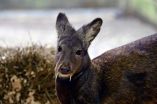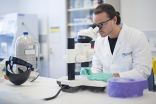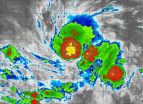(Press-News.org) In the war against Ebola one important hurdle has just been cleared – by a mouse.
Researchers at the University of North Carolina at Chapel Hill and colleagues have developed the first genetic strain of mice that can be infected with Ebola and display symptoms similar to those that humans experience. This work, published in the current issue of Science, will significantly improve basic research on Ebola treatments and vaccines, which are desperately needed to curb the worldwide public health and economic toll of the disease.
"You can't look for a cure for Ebola unless you have an animal model that mimics the Ebola virus disease spectra," said study co-author Ralph Baric, professor of epidemiology at the UNC Gillings School of Global Public Health and UNC School of Medicine. "For the first time, we were able to produce a novel platform for rapidly developing new mouse models that replicate human disease for this virus, as well as other important emerging human pathogens."
Typical laboratory mice usually do not develop human-like Ebola disease, including the severe symptoms that can prove fatal in humans. So the researchers asked whether all mice are immune to Ebola, or whether some strains of mice are susceptible; and if some are susceptible, could they harness the power of mouse genetics to figure out what genes make someone susceptible to the disease.
To find out, the team, including researchers from the University of Washington and the NIH Rocky Mountain National Laboratory, where the research took place, were able to breed together eight genetic mouse variants and successfully test a strain of mice to permit active research on potential Ebola vaccines and treatments. This model system more accurately reflected the human experience when infected with the virus.
The team was able to show that a combination of genes were involved in producing a range of disease symptoms, such that the genetic variation of the mice directly led to the variety of symptoms that the disease produced. What's more, the researchers pinpointed a single gene that accounted for much of that variation – a gene responsible for encoding a protein known as TEK.
"Public perception of Ebola infection typically focuses on the high mortality rate following hemorrhagic fever, but Ebola actually produces a range of disease symptoms," said co-author, Martin Ferris, a research assistant professor of genetics in the UNC School of Medicine. "During an outbreak, it is often difficult to assess the role that genetic variation plays in determining disease severity in people. And if we're going to develop treatments, then we need to know about this genetic variation."
Co-author Mark Heise, professor of genetics at the UNC School of Medicine, added, "the mice were part of the Collaborative Cross initiative at UNC-Chapel Hill, which was designed to better model human genetic diversity, and it has proven to be a powerful system for studying how genetic variation affects susceptibility to a number of emerging pathogens, including Ebola virus. It has been a tremendous program with big dividends."
INFORMATION: END
Improved mouse model will accelerate research on potential Ebola vaccines, treatments
Research first to develop a mouse model that more accurately reflects human experience when infected with Ebola
2014-10-31
ELSE PRESS RELEASES FROM THIS DATE:
Scientists trigger self-destruct switch in lung cancer cells
2014-10-31
CANCER RESEARCH UK scientists have found a drug combination that can trigger the self-destruct process in lung cancer cells - paving the way for new treatments, according to research that will be presented at the National Cancer Research Institute (NCRI) Cancer Conference in Liverpool next week*.
When healthy cells are no longer useful they initiate a chain of events culminating in self destruction. But cancer cells swerve away from this suicide path and become immortal. This means that cells grow out of control – causing tumours to form.
The Cancer Research UK ...
Tropical Depression Nuri now haunting the western Pacific Ocean
2014-10-31
Tropical Depression Nuri formed on Halloween morning, October 31, and is haunting the waters of the western North Pacific Ocean. NASA-NOAA's Suomi NPP satellite captured a ghostly-white image of the storm.
When Suomi NPP flew over Tropical Depression Nuri on Oct. 31 at 3:36 UTC, the Visible Infrared Imaging Radiometer Suite or VIIRS instrument aboard captured an infrared image of the storm. The infrared data shows temperature, an indicated that there were very high thunderstorms with very cold cloud top temperatures surrounding the center of the low level circulation ...
Strange, fanged deer persists in Afghanistan
2014-10-31
WCS study confirms that endangered musk deer still live in Nuristan Province – some 60 years after last sighting
Species targeted by poachers: Musk deer scent glands are more valuable than gold
Study appears in the October issue of the journal Oryx
NEW YORK (October 31, 2014) – More than 60 years after its last confirmed sighting, a strange deer with vampire-like fangs still persists in the rugged forested slopes of northeast Afghanistan according to a research team led by the Wildlife Conservation Society (WCS), which confirmed the species presence during ...
A matter of life and death: Cell death proteins key to fighting disease
2014-10-31
Melbourne researchers have uncovered key steps involved in programmed cell death, offering new targets for the treatment of diseases including lupus, cancers and neurodegenerative diseases.
The research teams from the Walter and Eliza Hall Institute worked together to discover the three-dimensional structure of a key cell death protein called Bak and reveal the first steps in how it causes cell death. Their studies were published in Molecular Cell and Proceedings of the National Academy of Sciences.
Programmed cell death, known as apoptosis, occurs naturally when ...
New step towards eradication of H5N1 bird flu
2014-10-31
A University of Adelaide-led project has developed a new test that can distinguish between birds that have been vaccinated against the H5N1 strain of avian influenza virus or "bird flu" with those that have been naturally infected.
This is a significant step in the fight against this often fatal strain of avian influenza which is widespread in the poultry populations of South East Asia, particularly Indonesia and Vietnam.
It causes global concern because of its possible transmission to humans and the threat of a pandemic if it mutates to a form that can be easily passed ...
'Divide and rule' -- raven politics
2014-10-31
Thomas Bugnyar and his team have been studying the behavior of approximately 300 wild ravens in the Northern Austrian Alps for years. They observed that ravens slowly build alliances through affiliative interactions such as grooming and playing. However, they also observed that these affiliative interactions were regularly interrupted by a third individual. Although in about 50 % of the cases these interventions were successful and broke up the two affiliating ravens, intervening can be potentially risky when the two affiliating ravens team up and chase away the intervening ...
Efficient genetic editing
2014-10-31
As potential next-generation therapeutics and research tools, few life sciences technologies hold more promise than genome-editing proteins – molecules that can be programmed to alter specific genes in order to treat or even cure genetic diseases.
There's at least one catch though – getting genome-editing proteins into cells, where they need to be to access the genome, is a major challenge, especially in live animals or human patients.
Conventionally, researchers have delivered the DNA encoding these genome-editing proteins into cells and then relied on ...
Countries can learn from Cyprus' 2013 economic crash, according to Imperial report
2014-10-31
In March 2013, Cyprus agreed to a €17 billion (£13.42 billion) international bailout by the International Monetary Fund (IMF), the European Central Bank (ECB) and the European Commission (EC).
The magnitude of the bailout was 100 per cent of Gross Domestic Product (GDP) and also involved a bank bail in. This is when the borrower's creditors are forced to bear some of the burden by having a portion of their debt written off in order for the bank to have sustainable level of debt.
The package of measures was aimed at preventing the country from facing the ...
Tweet much to gain popularity is an inefficient strategy
2014-10-31
The imbalanced structure of Twitter, where some users have many followers and the large majority barely has several dozen followers, means that messages from the more influential have much more impact. Less popular users can compensate for this by increasing their activity and their tweets, but the outcome is costly and inefficient. This was confirmed by an analysis of the social network performed by researchers from the Technical University of Madrid.
What can Twitter users do to increase their influence? To answer this question, a team of researchers at the Technical ...
Tropical Storm Vance's center looks like a pumpkin to NASA's Terra satellite
2014-10-31
Tropical Depression 21E strengthened overnight on Oct. 30 and by Halloween morning, Tropical Storm Vance was haunting the waters of the Eastern Pacific Ocean. In a false-colored infrared image from NASA's Terra satellite on Oct. 31, the strong thunderstorms around the center resemble a pumpkin.
Tropical Depression 21E formed on Oct. 30 after struggling for days as a low pressure area. Just a day later it strengthened into a tropical storm and was renamed Vance.
NASA's Terra satellite passed over Vance on October 31 at 4:55 UTC (12:55 a.m. EDT) – the witching hour ...
LAST 30 PRESS RELEASES:
Following cellular lineage
Alzheimer’s disease progresses faster in people with Down syndrome
Gender stereotypes in schools impact on girls and boys with mental health difficulties, study finds
Searching ICTRP: Dispensable for drug assessments, but essential for assess-ments of non-drug interventions
HIV epidemic cannot be ended without stopping former prisoners and other patients being lost to care
Nanoparticle delivery of FZD4 to lung endothelial cells inhibits lung cancer progression and metastases
Pioneering study targets Alzheimer's disease risk factors among Californians from the Middle East and North Africa
CO2 worsens wildfires by helping plants grow
University of Exeter to lead groundbreaking international cyber law project
Huge database gives insight into salmon patterns at sea
Fires pose growing worldwide threat to wildland-urban interface
Water main breaks are rarely due to a single factor, new Concordia research finds
MSU research suggests darker side of being politically confident
New findings in JNCCN illustrate pathway for screening high-risk individuals for pancreatic cancer in PRECEDE study
What’s behind canned wine’s rotten egg smell? Cornell team IDs the culprit
Using generative AI, Insilico Medicine discovers new class of Polθ Inhibitors for BRCA-deficient cancers
New A.I. project will allow industrial robots to be more freethinking
Computer scientist William Wang receives prestigious early career technical achievement award
UC Irvine researchers shine light on rapid changes in Arctic and boreal ecosystems
Trash to treasure – researchers turn metal waste into catalyst for hydrogen
Microplastics, algal blooms, seafood safety are public health concerns addressed by new Oceans and Human Health Centers
Alba Yerro-Colom to use National Science Foundation CAREER award to better predict and prevent landslides
Researchers discover urine-based test to detect head and neck cancer
Moffitt treats first clinical trial patient with gamma delta CAR T for bone metastatic prostate cancer
Wiley's latest natural products database release empowers drug discovery and research
Reproductive success improves after a single generation in the wild for descendants of some hatchery-origin Chinook salmon
New treatment method using plasma irradiation promotes faster bone healing
CNIC scientists identify therapeutic targets for the prevention of heart injury linked to cancer treatment
Older males out-compete young males when it comes to extra-marital breeding
Using machine learning to identify patients with cancer that would benefit from immunotherapy
[Press-News.org] Improved mouse model will accelerate research on potential Ebola vaccines, treatmentsResearch first to develop a mouse model that more accurately reflects human experience when infected with Ebola





